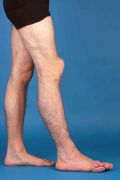Overgrowth syndromes

The tissue growth disturbance, maturation disorder or malformation of body tissues may not necessarily be limited to vessels alone, but may also affect other tissues tightly coupled to the vessels during embryonic development, primarily fatty tissue, musculature and bone tissues. As a result, in addition to the vessels, a circumscribed increased or reduced growth of these tissues or an entire extremity may be present; on very rare occasions, these malformations may also be more complex and affect internal organs.
These associations of vascular malformations with other anomalies such as soft tissue hyperplasia occur in the form of typical symptom constellations or syndromes. These syndromes are referred to in the ISSVA classification as a separate subgroup ("vascular malformations associated with other anomalies"). The most common syndromes are known as Klippel-Trénaunay syndrome (capillary-lymphatic venous malformation with limb hyperplasia) or Parkes-Weber syndrome (capillary-arterio-venous malformation with limb hyperplasia).
Other overgrowth syndromes with vascular malformations are the CLOVES syndrome (congenital hyperplasia of adipose tissue and bone, epidermal nevus and venous, capillary and lymphatic malformations) and the progressive Proteus syndrome (increasing, circumscribed hyperplasia of extremities, bones, cartilage and adipose tissue and muscle together with venous or lymphatic malformations).
Genetically the cause of these syndromes are so-called postzygotic mosaics (non-hereditary mutations that do not affect all body cells) with disorders mainly in the PIK3CA pathway responsible for the maturation and growth of various body tissues. This led to the definition of a spectrum of disease presentations called PROS (PIK3CA-Related Overgrowth Syndromes) which better defined older nomencalture. Drug therapies are currently being used in studies.
